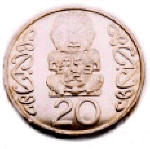Bank Notes
Five dollar note
Front

Sir Edmund Hillary (1919 - )
Sir Edmund Hillary is New Zealand's most accomplished explorer, gaining world renown in 1953 as the first person to climb Mt Everest. In 1958 Sir Edmund became the first person to drive overland to the South Pole.
Mount Cook / Aoraki
Mount Cook / Aoraki, in New Zealand's South Island, is New Zealand's highest mountain. It was the scene of Sir Edmund Hillary's earliest climbing successes, and is still regarded by Hillary as one of his favourite mountains.
Massey Ferguson tractor
It was on tractors such as this that Sir Edmund Hillary drove to the South Pole. A stalwart of New Zealand farming life, these tractors proved adaptable to the harsh Antarctic conditions, requiring only minor modifications.
Back

Campbell Island scene
Campbell Island is the southernmost of New Zealand's outlying islands - about 600 kilometres southeast of Stewart Island. Campbell Island has an area of 114 square kilometres. The Department of Conservation has recently eradicated all rats from the island as part of the largest island restoration project in the world.
Yellow-eyed penguin or hoiho (Megadyptes antipodes)
The distinctive thing about the yellow-eyed penguin is its yellow iris and
yellow band of feathers across the back of its head. The hoiho is unique to
New Zealand and is one of the world's rarest penguins. It can be found on sea-facing
scrub and forested slopes along the southeastern coastline of the South Island.
As well as Campbell Island, the hoiho can be found on Stewart and Auckland
Islands.
Its survival is threatened by habitat destruction by humans and predation of
chicks by stoats, dogs, ferrets and cats.
Subantarctic lily (Bulbinella rossii)
The subantarctic lily produces spectacular yellow flower heads in early summer and grows to a height of about one metre. It is unique to the subantarctic.
Daisy (Pleurophyllum speciosum)
A giant member of the daisy family, this plant has colourful white and violet flowers. On Campbell Island, the plants grow close to the ground to help avoid wind chill and have corrugated leaves to trap the limited solar energy available there.
Bull kelp (Durvillaea antarctica)
Bull kelp can grow up to several metres long and is found on New Zealand coasts as well as subantarctic islands. It has very tough skin and the strands are honeycombed inside for buoyancy.
Ten dollar note
Front

Kate Sheppard (1848 - 1934)
Kate Sheppard was the most prominent leader of the campaign for universal suffrage in New Zealand. She worked tirelessly to organise and promote her cause. A long campaign culminated in 1893 when New Zealand became the first country in the world to extend voting rights to women.
White camellia (Camellia japonica alba plena)
In 1893 white camellias were given to Members of Parliament who had supported the bill to give New Zealand women the vote. The flower has become a symbol of the fight for the vote by New Zealand women. The flowers on the ten dollar note are Camellia japonica alba plena.
Back

Blue duck or whio (Hymenolaimus malacorhynchos)
The rare blue duck is an endangered species which is found mainly in mountainous areas of New Zealand. It usually lives in pairs or family groups and prefers fast-flowing river habitats. Now totally protected, the whio is in a serious state of decline. At the present rate of decline the species will be functionally extinct (i.e. no more females remaining to breed) in some areas in the next ten years. Habitat degradation and introduced predators (notably stoats) are recognised as the primary threats to the whio's survival.
Parahebe catarractae
This riverside plant, a close relative of the hebe - the largest plant group unique to New Zealand - can be found in both North and South Islands. It grows in crevices in rocks, beside streams and sometimes in the spray of waterfalls. It can grow up to 60cm high and is notable for its trailing stems and attractive purple flowers.
Blechnum fern or mountain kiokio
This is a very common fern throughout New Zealand, which grows best in damp and shady places. In young plants like the specimen on the note, the fronds are tinged pink.
Twenty dollar note
Front

Her Majesty Queen Elizabeth II (1926 - )
This note features an official portrait of the Queen taken at Government House, Wellington, on 26 February 1986 by Ronald Woolf. Her Majesty is wearing the Sovereign's Badge of the Order of New Zealand. The ribbon is based on a taniko pattern.
Parliament buildings, Wellington
The $20 note shows two of the three buildings of the New Zealand Parliament, situated in Wellington. The older building, an imposing structure clad in Takaka marble, houses the Legislative Chamber. The foundations for this building were laid in 1912, but the First World War delayed construction and the building was not completed until 1922. The distinctive Beehive Executive Wing, designed by Sir Basil Spence, was begun in 1969 and completed in 1977.
Back

New Zealand falcon or karearea (Falco novaseelandiae)
Sometimes called the bush hawk, the New Zealand falcon is the most fearless of all our nation's birds. An adaptable hunter and a determined solitary predator, the falcon hunts small birds and animals and can attack at speeds of up to 200kph. The falcon is a high-country bird, seldom found north of Rotorua that favours isolated bush-clad mountain valleys.
Marlborough rock daisy (Pachystegia insignis)
This is a small spreading shrub unique to Marlborough and North Canterbury. The plant is a distinctive feature of the dry inland valleys of Marlborough with its thick leathery leaves and large, spectacular flower heads. It grows in inaccessible places such as cliff sides and the edges of steep scree slopes, and can flourish in areas from sea level to 1200 metres.
Flowering red tussock (Chionchloa rubra)
There are 13 species of tussock grass in New Zealand, and red tussock, which has a distinct red tinge to its leaves, is found in both the North and South Islands. Tussock grass flowers intermittently, is primarily found in alpine areas, and can live for up to 200 years.
Mount Tapuaenuku, Inland Kaikouras
The highest peak in the South Island's Inland Kaikoura range, Mt Tapuaenuku is 2,885 metres high and dominates the surrounding countryside. The view of the mountain on the $20 note is from the east side of the Inland Kaikouras, looking up from the Awatere Valley floor.
Fifty dollar note
Front

Sir Apirana Ngata (1874 - 1950)
Sir Apirana Ngata played a significant role in the revival of the Maori people and culture during the early years of the twentieth century. He was the first Maori to graduate from a New Zealand university, was an accomplished leader of the Young Maori Party and was an elected Member of Parliament for 38 years. Ngata was respected by both Maori and Pakeha and provided a focus for a social movement that rejuvenated Maori culture. He was also a driving force behind the revival of his own tribe, Ngati Porou.
Porourangi meeting house
Designed by Sir Apirana Ngata himself, the Porourangi meeting house stands at Waiomatatini Marae, near Ruatoria on the North Island's east coast, and is a showcase for Maori art.
Tukutuku pattern
The tukutuku pattern was designed by Sir Apirana Ngata and is known as "poutama porourangi". "Poutama" is the style of tukutuku pattern meaning "stairway to heaven" and "Porourangi" is the name of the Ngati Porou meeting house which features the pattern.
Back

Kokako or blue wattled crow (Callaeas cinerea)
The kokako is a large native bird with a distinctive steel-grey body and a
black face `mask'. The variety pictured on the note is the South Island kokako.
Kokako are much larger than a tui, and prefer to hop up trees to gain enough
height to be able to glide. They seldom fly further than 100 metres.
The Kokako are doing well in the sites where they are managed with pest control.
However, they continue to decline in other places.
Pureora Forest Park
Pureora Forest Park, established in 1978, covers 72,335 hectares close to Taupo in the central North Island. The park takes its name from nearby Mount Pureora (1130 metres). It is one of the most ecologically significant and beautiful forests in New Zealand and is home to a large population of kokako. Pureora has a dense interior with a huge variety of trees, shrubs, epiphytes and vines forming an almost impenetrable mass. Emergent podocarps include rimu, miro and matai, some of which may be over 1000 years old.
Supplejack or kareao (Ripogonum scandens)
Supplejack leaves are eaten by kokako, and the plant forms impenetrable thickets used by the birds for nesting. It can grow up to 5 cm a day in summer. Supplejack produces bright red berries once it emerges from the shade of the forest canopy.
Sky-blue mushroom (Entoloma hochstetteri)
This mushroom, notable for its bright blue colour that fades with age, grows throughout New Zealand in decomposing plant remains.
Hundred dollar note
Front

Ernest, Lord Rutherford of Nelson (1871 - 1937)
Internationally recognised as the `father of the atom', Ernest Rutherford changed the basic understanding of atomic science on three occasions: he explained the perplexing problem of naturally occurring radioactivity, determined the structure of the atom, and changed one element into another.
Nobel Prize medal and diagram
The Nobel Prize in Chemistry, which Rutherford received in 1908, is represented on the note. Overlaying the medallion is a graph plotting the results from Rutherford's investigations into naturally occurring radioactivity.
Back

Yellowhead or mohua (Mohoua ochrocephala)
The yellowhead, sometimes known as the bush canary, is a diminutive and colourful bird. It is found in tracts of native bush throughout the South Island, preferring the canopies and sub-canopies of beech forests. Yellowheads are in a serious state of decline due to rat and stoat predation.
Red beech or tawhairaunui (Nothofagus fusca)
Beech forests are one of the two main types of forest in New Zealand. Red beech grow up to 30 metres high and are named for the colour of their young leaves. Favouring warmer and more fertile sites than do other varieties of beech, their red wood is considered to be the most durable. Red beech is found in both North and South Islands and is the favoured habitat of the yellowheads in the Eglinton Valley.
Eglinton Valley
Located within the Fiordland National Park on the Te Anau-Milford Sound highway, the Eglinton Valley is home to a particularly fine stand of red beech and a declining population of yellowheads.
South Island lichen moth (Declana egregia)
Found in Fiordland beech forests, this distinctively patterned moth blends perfectly with the lichens that cling to the trunks of the trees. The caterpillar form is strikingly coloured but is just as skilled at disguising itself.
New Zealand's coins
How are our coins made?
Coins are made in two stages. To start with, blank circles are cut from long
sheets of metal. These blanks become coins when they pass through stamping
machines, which apply huge pressure to impress the distinctive "head" and "tail" features.
New Zealand's coins have predominately been made at the Royal Mints of Britain,
Australia and Canada, although at various times in the past the South African
Mint Company and Royal Norwegian Mint have manufactured our coins.
Although we usually refer to our coins as silver or gold, they are actually
made from a mixture of different metals and contain neither silver nor gold.
The `silver' coins (50, 20, 10 and 5 cent pieces) are a cupro-nickel compound
of 75 per cent copper and 25 per cent nickel. The gold-coloured $1 and $2 coins
are struck in an aluminium-bronze alloy of 92 per cent copper, 6 per cent aluminium
and 2 per cent nickel. Coins last, on average, for about twenty years.
Forgery of coins is fairly uncommon, simply because all the work in forging
a coin is hardly worth the small reward! Nevertheless, all designs on a real
coin should be clearly defined, and it should have a distinct ring when dropped
on a table-top, rather than a `thud'.
The Reserve Bank accepts for exchange any demonetised coins and notes (i.e.
currency no longer in circulation) at its Wellington head office. This includes
1 and 2 cent coins, which were phased out in 1989 and demonetised in 1990.
The Reserve Bank in March 2005 announced its decisions to modernise New Zealand's
silver-coloured coins. After extensive research and careful consideration of
the issues, the Reserve Bank has decided to follow through with its proposals
announced in November 2004.
The decisions are:
- the current 50, 20 and 10 cent coins will be made smaller, and of lighter and lower-cost plated steel; and
- the 5 cent coin will be taken out of circulation.
The $1 and $2 coins will be retained, as will the existing images on the 50, 20 and 10 cent coins, including that of the Queen.
Coin designs
Designs on the back of New Zealand's coins (the "tail" side) haven't
changed significantly since decimal currency was introduced in 1967. A 20 cent
piece featuring a Maori "pukaki" carving was released in 1990, because
the kiwi motif was moved to the $1 coin. The 20 cent piece with the kiwi is
still very common so you are likely to see both coins.
The "heads" design featuring the Queen's portrait was updated in
1986 and again in 1999. When the $1 and $2 notes were taken out of circulation
in 1991, they were replaced by the gold-coloured kiwi $1 coin and the $2 coin
featuring the kotuku.
Commemorative Currency
To mark special occasions, or to honour special people, commemorative coins
are produced from time to time by the Reserve Bank and are marketed by NZ Post
Ltd. These coins are legal tender, but do not circulate.
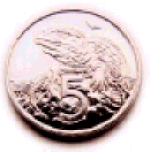
Five cents
Alloy: Cupro-nickel
Diameter: 19.43mm
Weight: 2.83g
Design: The last surviving member of an otherwise extinct
family of reptiles, the tuatara, native only to New Zealand, is shown sitting
on a coastal rock.
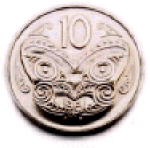
Ten cents
Alloy: Cupro-nickel
Diameter: 23.62mm
Weight: 5.66g
Design: A Maori carved head or koruru with Maori rafter
patterns.
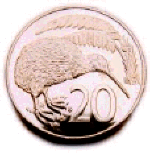 |
|
Twenty cents
Alloy: Cupro-nickel
Diameter: 28.58mm
Weight: 11.31g
Design: There are two designs currently in usage. One features
a representation of a well-known Maori "pukaki" carving. The other
design in common usage features the kiwi.
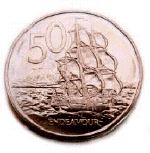
Fifty cents
Alloy: Cupro-nickel
Diameter: 31.75mm
Weight: 13.61g
Design: The barque Endeavour, commanded by Captain
Cook, sailing south, with Mount Taranaki or Egmont in the distance.
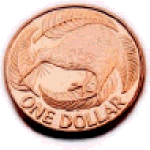
One dollar
Alloy: Aluminium bronze
Diameter: 23mm
Weight: 8.0g
Design: New Zealand's national bird, the kiwi, brings reality
to the colloquial term, `Kiwi Dollar'.
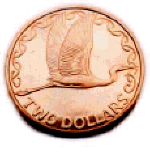
Two dollar
Alloy: Aluminium bronze
Diameter: 26.5mm
Weight: 10.0g
Design: The kotuku (white heron) is one of New Zealand's
rarest birds and is held in particularly high regard in Maori mythology.
Currency timeline
1840
Standard gold, silver and bronze British coins, as well as other foreign coins,
circulate freely in New Zealand based on their precious metal content.
1857-1881
Coin shortage means that some retailers issue their own tokens.
1897
Only British coins struck by the Royal Mint become New Zealand's legal tender
coinage.
1914
Gradual withdrawal of gold coin from circulation.
1920
Silver content in coins reduced (debased) from .925 (Sterling) to .500 fine.
1933
New Zealand introduces its own coinage.
1934
Reserve Bank of New Zealand issues first series of bank notes.
1935
British coinage ceases to be legal tender in New Zealand.
1940
Second series of bank notes introduced.
1940
Bronze coins (penny and halfpenny) issued for the first time.
1947
Cupro-nickel coins first appear in circulation, replacing silver coins.
1967
Change to decimal currency. Third series of bank notes issued.
1981-1983
Fourth series of bank notes issued.
1989
Stopped issuing 1 and 2 cent coins. Demonetised in April 1990.
1990
New Maori "pukaki" carving 20 cent coin issued.
1991
$1 and $2 coins issued. $1 and $2 notes demonetised in April 1993.
1992-1993
Fifth series of bank notes issued, bearing first new designs since 1967.
1999-2000
Sixth series of bank notes issued in polymer.
A brief history of New Zealand's currency
Early days
Before the first Europeans arrived in New Zealand, Maori did not use currency.
Items of value were traded by barter. When Europeans first settled here, Maori
and Pakeha traded in this way as well, until coins started to appear around
the 1830s.
From this time, traders from all nations and European colonists brought to
New Zealand a variety of coins, mostly British. There weren't many bank notes
around at that time, generally because the notes were of higher value than
were needed for transactions. Early bank notes were issued by individual banks
and payable (usually in gold or coin) only by those banks. At first, there
were few printing facilities in New Zealand, so the durability of coins was
a real advantage.
In early 1840, William Hobson, New Zealand's first Governor, proclaimed that
British laws should apply to New Zealand. British coins became subject to the Imperial
Coinage Act, 1816 (UK) after the introduction of the English Laws
Act in 1858. Because of this Act, British coins in use since 1840 retrospectively
became legal tender.
In the 1840s and 1850s there was an extreme shortage of coins, especially copper
coins. Traders tried the issue of low value paper notes to remedy this situation
but this was soon abandoned. Instead, as this shortage intensified throughout
the 1850s, businesses in Auckland and Dunedin decided to issue the first copper
tokens in 1857. In all 48 traders throughout New Zealand (mostly retailers
such as merchants, grocers, drapers and milliners) decided to issue their own
penny and halfpenny tokens. Tokens were profitable for the traders because
the cost of producing them was well below their nominal face value and many
were never cashed in or were lost. They were also a good source of advertising
as each token carried the business's name and service. Tokens were last issued
from Christchurch in 1881 and their use gradually declined during the 1880s
In 1897, New Zealand's currency became subject to certain provisions stated
in the Imperial Coinage Act, 1870 (UK). This meant that only British
coin became the official legal tender coin of the colony. At that time, it
was already one of the two `common' currencies, along with Australian minted
gold sovereign and half sovereign coins
By the late nineteenth century, bank notes were becoming more common. By then,
there were six banks operating in New Zealand, each issuing its own notes.
The problem with this was that none of the notes being issued by the various
banks were the same size or design and there was a large variety of different
notes for each of the common denominations. It wasn't until 1924 that banks
finally co-ordinated the size and colour of notes. A bank was not obliged to
accept another bank's notes either, although most usually did.
In 1934, the Reserve Bank of New Zealand was established as New Zealand's central
bank and was given sole authority by the government to issue bank notes. This
ended circulation of the trading banks' notes.
The Reserve Bank issues bank notes
The first Reserve Bank of New Zealand notes were issued at the beginning of
August 1934.
These first notes were supposed to be only temporary, as they had been hastily
designed. A committee to prepare the designs had been formed just the year
before and there had been heated debates over what the notes should look like.
The designs that the committee finally agreed upon included features from the
Bank of New Zealand notes that were already in circulation.

The designs included a portrait of the Maori King Tawhiao (who had attempted
unsuccessfully to issue his own notes in 1885), a kiwi, and the Arms of New
Zealand. The notes included the signature of the first Governor of the Reserve
Bank, Leslie Lefeaux. All the notes carried the same design, but different
colours distinguished denominations. Notes of 10/- (ten shillings), 1
(one pound), 5 and 50 were issued, coloured orange, mauve, blue-green
and red respectively.
The Reserve Bank's second note issue was in 1940, timed to coincide with New
Zealand's centennial celebrations. These notes had quite different designs
for each denomination, but were the same colours as before, except for slight
changes to avoid confusion between the 10/- and 50 notes. A green coloured 10
denomination note was also introduced at this time. The Reserve Bank's Chief
Cashiers signed this and following note issues. These notes remained in circulation
up until the change to decimal currency in 1967.

Although the Reserve Bank issued bank notes, for many years the New Zealand
Treasury was responsible for designing and issuing coins. The first distinctively
New Zealand coins were introduced in February 1933 as a result of a proclamation
issued under the Coinage Act in that year. Minted by the Royal Mint in London,
these coins were the same as the weight, size and denomination of British coins.
Silver coloured coins, made of an alloy of 50% silver and 50% copper, were
issued from 1933, and bronze pennies and halfpennies were introduced in 1940.
In 1947 the silver coloured coins were changed to an alloy of copper and nickel
when silver became too costly.
It wasn't until 1989, when government services were rationalised, that the
Reserve Bank gained authority over coinage. At the same time, one and two cent
coins were withdrawn from circulation and ceased to be legal tender in early
1990.
The changeover to decimal currency
The concept of decimal currency had been discussed for a long time in New
Zealand. Way back in 1933, a changeover to decimal coinage had been suggested
by the New Zealand Numismatic Society. The attraction of decimal currency was
its simplicity when doing calculations. By contrast, the `imperial' system
of currency was complicated and difficult to master. Under the imperial system,
pounds were divided into twenty shillings, and subdivided further into 240
pence (making twelve pence per shilling). In 1933, decimal currency was rejected
because it would have been too expensive to put in place at that time, especially
as New Zealand was in the midst of the Great Depression.
In 1957, a special committee was set up by the Government to take another look
at the pros and cons of introducing decimal currency. This paved the way for
New Zealand's move to decimal currency. In August 1963, the Government announced
that 10 July 1967 would be `DC Day', and a massive publicity campaign was organised
to smooth the shift from the imperial to decimal system.
Public discussions were held as to what the new decimal unit might be called,
and suggestions such as the "kiwi" and the "zeal" were
debated before the "dollar" was finally settled upon. Many New Zealanders
remember "Mr Dollar", a cartoon character that symbolised the changeover.
On DC Day, dollars and cents replaced pounds, shillings and pence as New Zealand's
units of currency.

In 1990, the Reserve Bank decided to completely revamp the appearance and features
of New Zealand's bank notes - the first overhaul since the introduction of
decimal currency in 1967. The result, after the Reserve Bank had consulted
widely with the New Zealand public, was an all-new series of notes with a distinctive
New Zealand look. The designs were changed slightly in 1999 when the Reserve
Bank introduced polymer bank notes.
Defacing bank notes
The Reserve Bank Act 1989 says that "No person shall, without the prior consent of the Bank, wilfully deface, disfigure, or mutilate any bank note." A person can be fined up to $1,000 if caught defacing a bank note.
Are damaged notes worth anything?
If you come across a badly damaged bank note, don't throw it away, as it will normally have some value. The Reserve Bank is liable to pay on currency it issues, provided that the note is not so badly damaged that it is unrecognisable. In extreme cases, individual assessments of notes may need to be made. As a rule of thumb, if you have more than half a note, the Reserve Bank will pay its full value. To receive payment on a damaged note, you need to present it to a bank or to the Reserve Bank in Wellington.
Reproducing or imitating currency
It is an offence to reproduce or imitate currency without the prior consent
of the Reserve Bank. The Reserve Bank Act says that you cannot "make,
design, engrave, print, or reproduce; or use, issue, or publish any article
or thing resembling a bank note or coin or so nearly resembling or having such
a likeness to a bank note or coin as to be likely to be confused with or mistaken
for it". The Bank has issued guidelines which can be found on our web
site at: -
www.rbnz.govt.nz/currency/money/index.html
Reviews / Comments for Bank Notes
No reviews have been written write a review now.

